When handling damage caused by contractors, it is vital to assess and document the damage thoroughly, including photographic evidence and detailed written descriptions. Contractors are liable for maintaining a safe and compliant worksite, and indemnification clauses outline subcontractor responsibilities. Effective communication with the contractor and understanding of contractual obligations are also essential. By taking a strategic approach to documenting damage and steering through dispute resolution, individuals can optimize claim settlements and explore further avenues for resolving contractor disputes.
Key Takeaways
- Document all damage thoroughly with photos, videos, and detailed written descriptions to establish facts and support claims.
- Notify the contractor promptly and maintain records of all communications to ensure a clear audit trail.
- Review contracts carefully to understand the contractor's obligations and liability for damage, including insurance coverage and compliance.
- Consider consulting with public adjusters to facilitate higher claim payouts, optimize the claim process, and negotiate with insurers.
- Explore all available remedies, including filing insurance claims, seeking mediation or arbitration, and pursuing litigation if necessary.
Assessing the Damage
When damage is caused by contractors, the assessment process is vital in determining the extent of the damage and identifying the necessary steps to rectify the situation. A thorough assessment requires the collection of detailed damage documentation, including an inventory of damaged areas, photographic evidence, and detailed notes on the damage.
To guarantee uniform collection of information, assessors use checklists to document the source and extent of structural damage, damage to materials and finishes, and any pre-existing conditions. Evaluating and recording damage details involves noting visible issues, such as broken items and scratches, and documenting communications with the contractor.
Organizing evidence and reports in a clear and concise manner is important for stakeholders to understand the extent of the damage and the steps required to address it. Effective damage documentation facilitates the development of a plan to rectify the situation and prevents further complications. Working with public insurance adjusters can increase settlement amounts by 30-50% when filing claims for contractor-caused damage.
Contractor Liability and Accountability
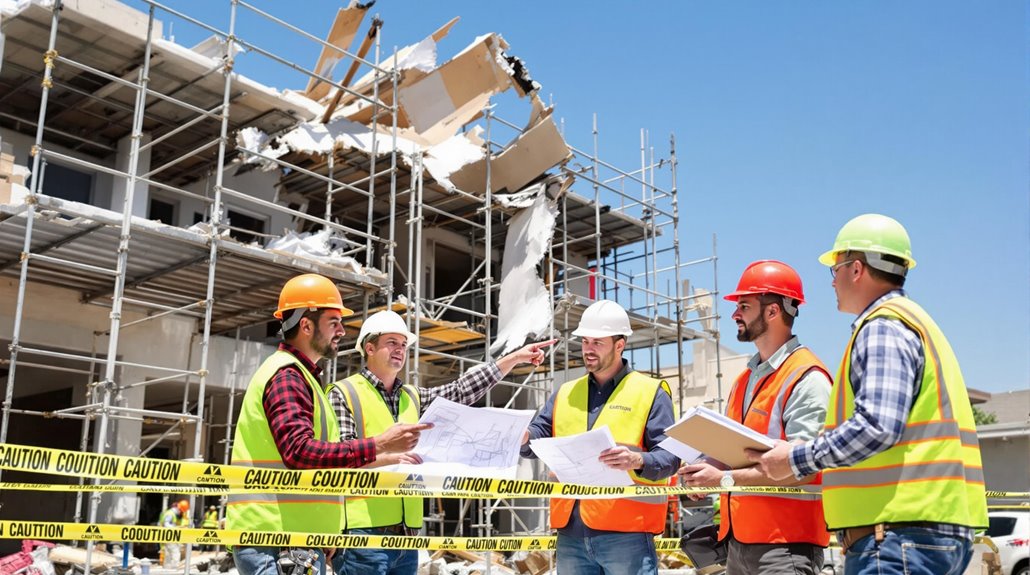
The concept of contractor liability and accountability is a critical aspect of the construction industry, as it determines the extent to which contractors can be held responsible for damages, injuries, or other issues that arise during a project.
Contractors are responsible for maintaining a safe and compliant worksite, and can be held liable for incidents due to unsafe conditions or poor supervision. They are also liable for the actions of their subcontractors, particularly if they fail to guarantee proper insurance coverage or qualifications for the job.
Contractor liabilities extend to subcontractor responsibilities, where subcontractors are accountable for the quality and safety of their work. They can be held financially responsible for claims tied to their work, as outlined in indemnification clauses.
To mitigate risks, contractors must perform due diligence on the project, manage risks proactively, and define clear roles and responsibilities for all parties involved to minimize shared liability.
When damages occur, claims adjusters typically review police reports and interview witnesses to determine the extent of contractor liability and appropriate settlement amounts.
Communicating With the Contractor

Effective communication with the contractor is essential in the event of damage, as it enables prompt reporting and facilitates a resolution to the issue.
A clear and detailed notification of the damage should be provided to the contractor, along with supporting documentation and evidence.
Reporting the Damage
Upon discovering damage caused by a contractor, it is vital to take immediate action to document and report the issue to secure a prompt and fair resolution.
Conducting a thorough damage assessment is key to establish contractor responsibility. To effectively report the damage, consider the following steps:
- Document the damage through photographs and videos to create a visual record.
- Collect evidence to support the claim, including witness statements and expert opinions.
- Determine the cause of the damage to identify if it is directly related to the contractor's work.
- Verify if the contractor has relevant insurance coverage to facilitate potential claims.
- Keep detailed records of correspondence and invoices related to the issue to maintain a clear audit trail.
Seeking a Resolution
Initiating a resolution process after discovering damage caused by a contractor requires a strategic approach to communication. Effective mediation and negotiation strategies are essential in resolving disputes efficiently.
It is important to establish regular communication channels to report and discuss issues promptly, preventing escalation. Detailed documentation of all communications should be kept, and clear expectations and deadlines for responses should be set.
Understanding contractual obligations, rights, and dispute resolution mechanisms is also critical. Identifying specific clauses related to damage claims and resolution processes can facilitate the resolution process.
Documenting the Issue
Documenting the issue thoroughly and efficiently is a critical component of the resolution process when dealing with damage caused by a contractor. Effective documentation enables clear communication with the contractor, facilitates resolution, and provides a solid foundation for potential legal action.
- Take photographs or videos of the affected areas from multiple angles to serve as evidence of the damage.
- Organize photo documentation and written notes in a systematic and accessible manner to facilitate evidence organization.
- Include descriptions of the damage, location, date, time, and any other relevant details in the documentation.
- Obtain reports from licensed contractors or experts to assess the damage and its causes.
- Gather written estimates from reputable contractors to determine the cost of repairing the damage.
Reviewing the Contract

How thoroughly do employers review contracts before hiring contractors to undertake significant projects? A thorough review of the contract is essential to guarantee that the employer's interests are protected in the event of damage caused by the contractor.
Contractual compliance and environmental obligations are key aspects to review. Employers should verify that the contract outlines the contractor's obligations to comply with local and international environmental regulations, as well as their responsibility to keep the site clean at all times.
Additionally, the contract should provide mechanisms for the employer to review the contractor's detailed design and performance tests. The employer should also confirm that the contract outlines procedures for resolving disputes and that insurance provisions are in place.
A thorough review of the contract will help employers to identify potential risks and guarantee that they are adequately protected in the event of damage caused by the contractor.
Documenting the Damage
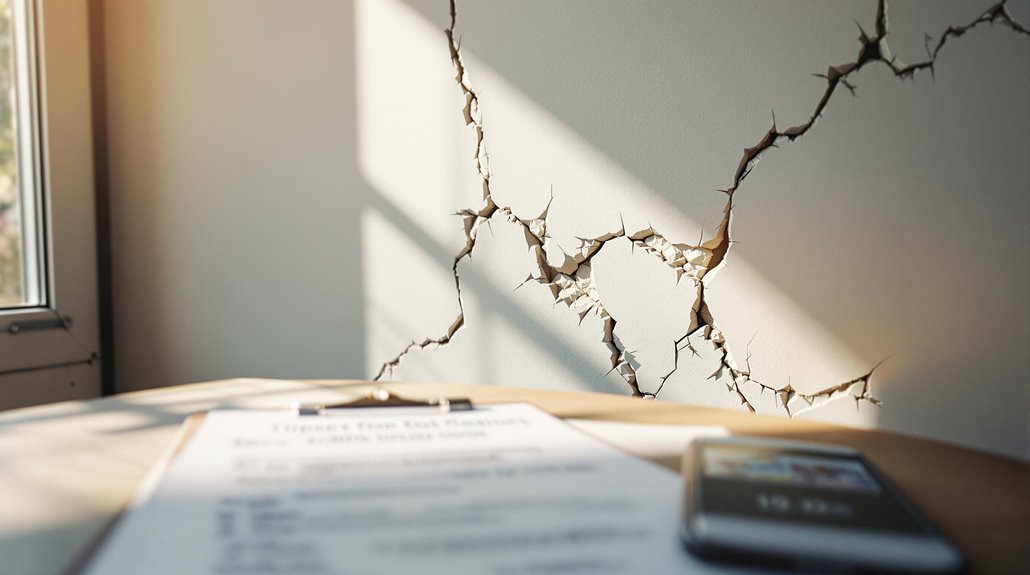
In cases where contractor-caused damage has occurred, a meticulous and methodical documentation process is instrumental in establishing the facts and building a robust claim. Effective documentation methods are essential in resolving disputes with contractors.
One critical aspect of documentation is visual evidence, which can be obtained using various photographic techniques.
Some key steps to evaluate when documenting damage include:
- Examining the damage thoroughly to identify and record the extent of the damage
- Employing photographic techniques to capture high-resolution images and videos of defects from multiple angles
- Maintaining detailed written descriptions of each defect, including information about the location, nature, and extent of the damage
- Keeping records of all communications with the contractor, including dates, times, and summaries of conversations
- Obtaining professional inspection reports from licensed contractors or construction experts to support the claim.
Seeking Compensation and Insurance Claims
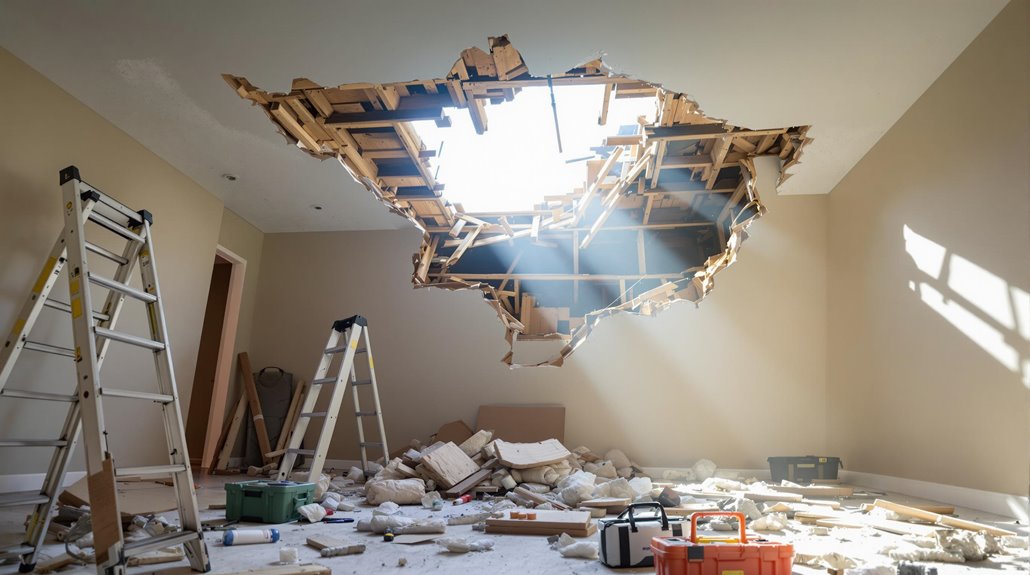
Once damage caused by contractors has been thoroughly documented, property owners can initiate the process of seeking compensation through insurance claims.
Effective claims necessitate meticulous records of damages, including photographic evidence and detailed accounts of incidents.
Working with public adjusters can increase settlement amounts by 30-50% for property damage claims.
Documenting the Damage
Thorough documentation of damage is an essential step in seeking compensation and filing insurance claims for damages caused by contractors. Effective damage documentation provides a clear understanding of the extent and cause of the damage.
Key components of damage documentation include:
- Conducting a thorough inspection to identify visible damage
- Capturing high-resolution photographic evidence from multiple angles to provide a complete view of the damage
- Creating detailed written descriptions of each defect
- Obtaining professional inspection reports to provide an expert assessment of the defects
- Getting repair estimates from reputable contractors to determine the cost of fixing the defects
Creating a thorough documentation trail helps ensure accountability and streamlines the insurance claim process.
Filing Insurance Claims
Most insurance claims against contractors are resolved through a combination of effective documentation, open communication, and a clear understanding of the claims process.
To initiate the insurance claim steps, homeowners should notify the contractor about the damage as soon as possible and maintain a record of all communications. If the contractor is unresponsive or unwilling to accept responsibility, homeowners may need to file a claim directly with the contractor's insurance company.
Understanding the contractor's insurance policies is essential in guiding the claims process. Homeowners should gather evidence of the damages and cooperate with the insurance adjuster to support the claim.
For complex contractor damage claims, working with public insurance adjusters can result in settlements up to 800% higher than handling the claim alone.
Navigating Dispute Resolution
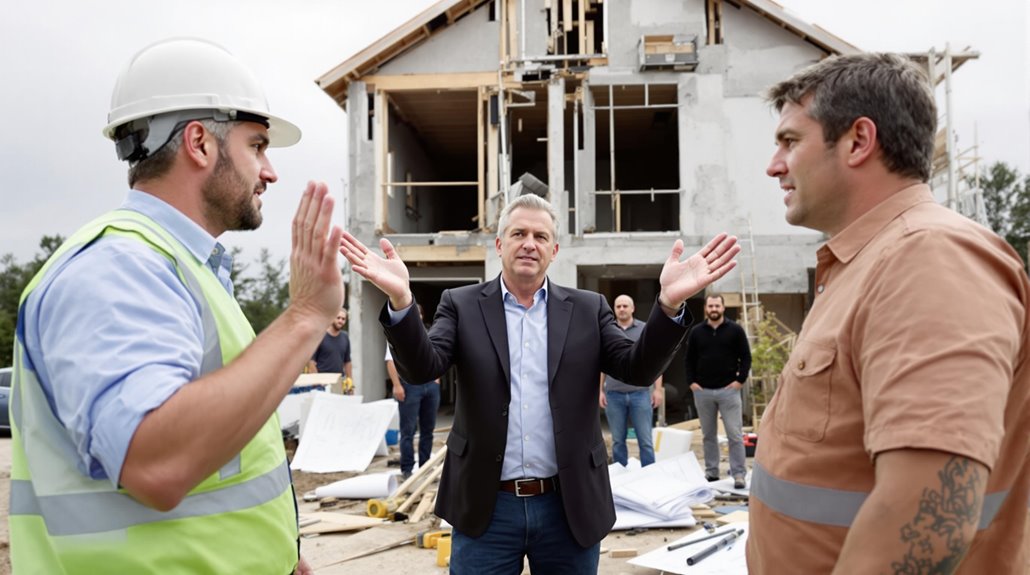
While construction projects often involve multiple stakeholders and complex contractual agreements, disputes between contractors and clients or property owners can still arise despite meticulous planning. Steering dispute resolution requires a broad approach, involving various techniques and processes to resolve conflicts efficiently.
Effective dispute resolution methods include:
- Negotiation: focusing on cooperation to find solutions without resorting to legal proceedings.
- Mediation strategies: employing neutral third-party facilitators to guide discussions and promote mutually beneficial agreements.
- Arbitration processes: presenting disputes to a neutral arbitrator or panel, which issues a binding decision.
- Dispute review boards: providing unbiased evaluations of disputes to facilitate resolution.
- Confidentiality: maintaining privacy and promoting open communication to resolve disputes more efficiently and cost-effectively than litigation.
Pursuing Legal Remedies
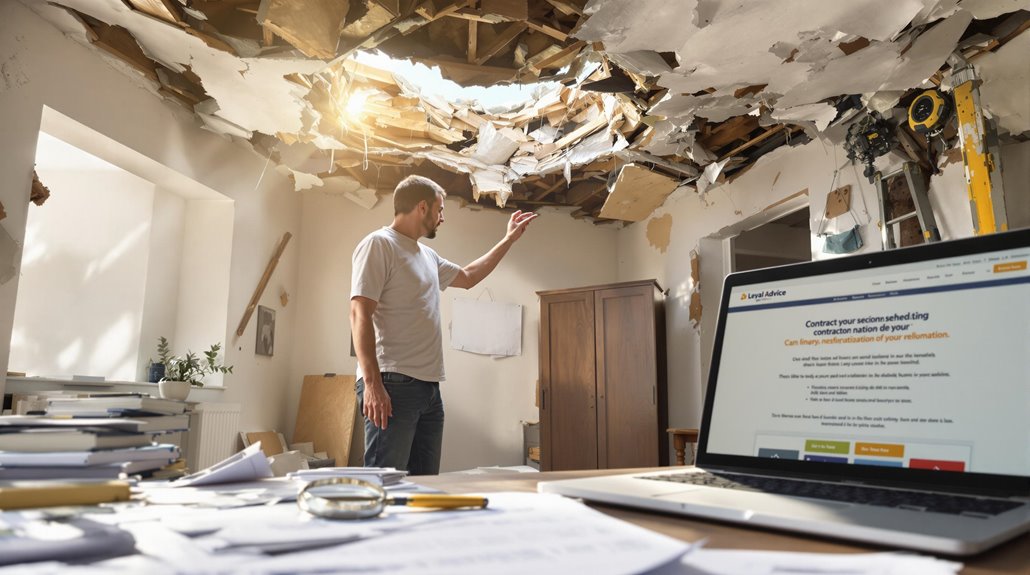
When negotiation, mediation, and other dispute resolution methods fail to yield a satisfactory outcome, property owners may need to contemplate pursuing legal remedies to address damage caused by contractors.
In such cases, litigation options may be explored, including filing a lawsuit against the contractor for breach of contract or negligence. To establish liability, property owners must demonstrate that the damage was caused by the contractor's failure to perform work with the skill and care expected in their field.
Alternative remedies, such as damages, specific performance, repudiation, reformation, and rescission, may also be available, depending on the specific circumstances of the breach and the terms of the contract.
It is essential for property owners to assess and document the damage thoroughly, gather multiple repair estimates, and review the contract to understand their legal obligations and rights before pursuing a claim.
Seeking legal advice is recommended to navigate the process.
While general contractors typically carry liability insurance, property owners should be aware that wear and tear issues are commonly excluded from coverage.
The Benefits Of Consulting A Public Adjuster

Public adjusters possess specialized expertise in insurance claims, enabling them to navigate complex regulations and secure fair compensation for property owners.
By providing objective assessments of damage, they help guarantee that repair costs are accurately documented and claimed.
Through streamlined claim processes, public adjusters facilitate higher claim payouts and more thorough settlements, effectively mitigating the financial burdens associated with contractor-caused damage.
Working with pre-vetted expert adjusters ensures professional representation from experienced professionals who maintain high standards of conduct and regular client communication.
Expertise In Insurance Claims
How can property owners maneuver the intricate and often overwhelming process of filing insurance claims, particularly when damage has been caused by contractors? Consulting a public adjuster can provide expertise in insurance claims.
They possess in-depth knowledge of insurance policies and procedures, enabling them to interpret policy specifics and maneuver the claims process effectively.
- Knowledge of insurance policy specifics to guarantee all entitled benefits are claimed
- Expertise in maneuvering the claims process to reduce confusion and missteps
- Ability to interpret fine print in insurance policies
- Awareness of insurer tactics to minimize payouts
- Familiarity with policy maneuvering to guide through the complex insurance landscape
Their expertise in insurance policy interpretation and claim process maneuvering can help property owners maximize their settlement and reduce stress associated with the claims process. Studies show that working with public adjusters increases settlements by 20-50% compared to handling claims independently.
Objective Damage Assessment
Objective damage evaluation is a critical component of the insurance claims process, particularly when damage has been caused by contractors. It guarantees meticulous documentation of all visible and hidden damages through an extensive property evaluation.
A detailed estimate of repair costs based on current market rates is also provided. This damage evaluation process includes evaluating damage to personal property, structural elements, and potential secondary issues like mold or smoke damage.
Public adjusters play a key role in this process, working with a network of professionals to appraise the extent of the damage. They inspect the property, documenting all types of damage, and provide a second opinion if disagreements arise over the insurance company's estimate, ultimately helping to maximize the claim settlement.
Licensed professionals must maintain independence from both insurance companies and roofing contractors to ensure unbiased assessments.
Streamlined Claim Process
The thorough damage evaluation process facilitated by public adjusters sets the stage for a streamlined claim process, which is essential for securing a fair and timely settlement.
By leveraging claim optimization strategies and paperwork best practices, public adjusters can guarantee that all necessary documentation is accurately prepared and submitted to the insurance company.
- Efficient documentation and paperwork management to minimize delays
- Extensive documentation gathering and organization to support the claim
- Professional presentation of the claim to the insurance company
- Reduced administrative burden on the policyholder
- Accuracy and attention to detail to prevent errors and omissions
This streamlined approach enables public adjusters to effectively navigate the claims process, ensuring that policyholders receive the compensation they deserve.
With contingency fee arrangements of 5-20% of the final settlement, public adjusters provide their expertise without requiring upfront payment from property owners.
Higher Claim Payouts & Settlements
Sophistication in guiding through the intricacies of insurance claims is a pivotal determinant of securing higher claim payouts and settlements.
Public adjusters bring expertise in managing claims, leveraging their in-depth knowledge of insurance laws and regulations to present detailed claims that maximize correct settlements. Their authorization to represent policyholders enables effective claim negotiation, counteracting insurance companies' tactics to minimize payouts.
Public adjusters' proficiency in damage assessment guarantees accurate identification of all damages, facilitating thorough claim submissions. By securing adequate insurance proceeds, public adjusters empower contractors to undertake more extensive repair projects, ultimately leading to higher claim payouts.
Their involvement considerably enhances the potential for fair settlements, underscoring the benefits of consulting a public adjuster for successful claim resolution.
About The Public Claims Adjusters Network (PCAN)

Membership in the Public Claims Adjusters Network (PCAN) affords numerous benefits to policyholders steering complex insurance claims. PCAN members have access to a network of experienced public adjusters who specialize in advocating for policyholders' interests. These professionals possess deep understanding and extensive experience in guiding insurance policies and claims processes, ensuring that policyholders receive fair and maximum claim benefits.
Some key benefits of PCAN membership include:
- Expertise in public adjuster roles, ensuring effective management of the claim process
- Proven insurance negotiation strategies to secure higher claim payouts
- Thorough support throughout the claim process, from initial assessment to final settlement
- Access to a global network of public adjusters with vast experience in handling various types of claims
- Adherence to industry standards and regulations, ensuring ethical and professional conduct in all claim-related matters
References
- https://www.acquisition.gov/far/52.247-21
- https://manuu.edu.in/dde/sites/default/files/DDE/DDE-SelfLearnmaterial/BA-6thSemester/Englishba6th28may24.pdf
- https://www.floridahardhatlaw.com/liability-and-damages-for-breach-of-a-florida-construction-contract/
- https://www.aupress.ca/app/uploads/OER-202302_Chamberlain_Dubberlboer_2023-Read-Think-Write.pdf
- https://www.cashforhousesfl.com/blog/steps-to-take-if-a-contractor-damages-your-property-in-florida/
- https://www.spireconsultinggroup.com/services/dispute-resolution/damage-assessment-quantification/
- https://www.fema.gov/sites/default/files/documents/fema_pa-ida-checklist_05-18-21.pdf.pdf
- https://dl.icdst.org/pdfs/files4/e1f57bc9ede07bcfc447d7d5f97b71ea.pdf
- https://www.avnergat.com/contractor-damages-property/
- https://blog.magicplan.app/damage-assessment-documentation








